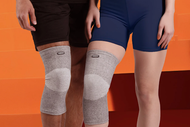Discover how to build your personal active recovery workout, understand its benefits, and learn about the role of recovery wear in improving its results!
Discover how to build your personal active recovery workout, understand its benefits, and learn about the role of recovery wear in improving its results!
As we age, maintaining an active lifestyle can become challenging, especially in light of joint pain or post-exercise discomfort. Active recovery workouts offer a solution, striking a balance between rest and continued activity to aid in recovery and maintain mobility.
In this article, we'll explore what an active recovery workout is, how to build a personalized one, and its numerous advantages. Additionally, we'll delve into different types of such workouts and the pivotal role recovery wear plays in enhancing their benefits. This guide aims to help you keep moving comfortably and confidently, no matter your age or activity level!
An active recovery workout refers to a lower intensity workout that you perform after strenuous exercise sessions. It’s designed to help your body recover and repair itself more efficiently than complete rest. While it might seem counterintuitive, engaging in light physical activity can actually speed up the recovery process.
These workouts involve low-intensity, low-impact exercises that take your body through a full range of motion without overloading your joints or muscles. They focus on gentle movements and stretching, giving your body the chance to 'reset' itself and prepare for your next high-intensity workout.
Contrary to passive recovery, which involves absolute rest days, an active recovery day keeps the body moving, promoting blood flow and nutrient delivery to sore muscles. It's an integral part of a well-rounded fitness regimen, particularly for those leading a physically active lifestyle
Planning your active recovery days shouldn't be a daunting task. Instead, it's about finding light activities that you enjoy, will keep you moving, and help expedite your body's recovery process. Here are some strategies to guide you in building an effective recovery workout:
Identify your low-intensity activities: Select exercises that you find enjoyable and relaxing, yet provide a gentle exercise to your body. This could be a leisurely walk, a light cardio exercise, swimming, or cycling. The key is to keep the level of intensity lower than your regular workouts.
Incorporate flexibility and mobility exercises: These help remove the stiffness from your muscles and improve your overall range of motion after intense exercise. They can include dynamic stretching, yoga poses, or Pilates exercises.
Plan for short workout sessions: Recovery workouts don't need to be long. Short sessions, around 20-30 minutes, are generally sufficient. Remember, the aim is to facilitate recovery, not add further fatigue.
Stay low-impact: Avoid active recovery exercises that could potentially strain your joints or muscles. Stick to movements that are smooth and easy on your body.
Listen to your body: If a certain activity causes you discomfort beyond the usual muscle soreness, it's important to stop and consult with a professional personal trainer.
Active recovery workouts aren't about filling in your rest days with light activity only—they offer a range of health and fitness benefits that contribute to enhanced performance and overall well-being. Let's explore some active recovery benefits in more detail.
Post-exercise recovery techniques are designed to expedite the body's natural healing process. By engaging in low-intensity movements, you promote better oxygen and nutrient delivery to your strained muscles and tissues, leading to quicker repair and regeneration.
Light exercise during an active recovery workout helps to increase blood flow throughout the body. Improved blood circulation ensures that your muscles receive an ample supply of oxygen and nutrients, which are essential for muscle repair and growth.
Additionally, improved circulation can aid in flushing out toxins from the body and improving delayed onset muscle soreness, further contributing to speedy recovery.
Active recovery sessions can be instrumental in preventing injuries. Regular inclusion of low-impact and flexibility exercises in your regimen can improve your overall joint mobility and muscle elasticity. This reduces the chance of experiencing injuries such as muscle strains or sprains during a tough workout.
High-intensity workouts lead to lactic acid buildup in the muscle group you train, which can result in discomfort and muscle fatigue. Active recovery workouts help to alleviate this issue. By improving blood circulation, these workouts aid in the quicker breakdown and removal of lactic acid from the body, reducing muscle soreness and enhancing overall performance for future workouts.
When it comes to active recovery workouts, the options are limitless. Here are some types of active recovery workouts to consider for your exercise routine:
Light Cardio: Activities like walking, cycling, or swimming on a rest day can be perfect for active recovery. These low-intensity exercises help increase blood circulation without straining your muscles or joints.
Yoga: Yoga helps improve flexibility and mobility and promotes mindfulness and relaxation, providing a mental break along with physical.
Pilates: Similar to yoga, pilates is a low-intensity exercise that focuses on core strength, flexibility, and mindful movement.
Stretching and Foam Rolling: Stretching helps to increase your range of motion and alleviate muscle tension. Foam rolling, also known as self-myofascial release, can help relieve muscle soreness and hasten the recovery process.
Low-Intensity Resistance Training: Light resistance training using body weight or light weights can help keep your muscles engaged without causing strain.
Remember that these are just options, and the best active recovery workout for you will depend on your personal preferences, fitness level, and health considerations.
Just as the right type of exercise is crucial to an effective active recovery workout, so too is the appropriate workout gear. Enter recovery wear, a category of activewear designed specifically to enhance the recovery process. Among the best in this category is our Thermo Recovery Wear, specially designed to aid post-exercise recovery and alleviate chronic muscular and joint pain.
Thermo Recovery Wear products, like the Knee Sleeve, Elbow Sleeve, and Dual Shoulder Sleeve, are embedded with semiconductors that transform your body heat into therapeutic far-infrared waves, helping to relieve chronic muscular and joint pain by more than 62%.
By wearing these during your active recovery workouts, you're not only supporting your body's natural recovery processes but also addressing any discomfort in your joints or muscles.
Ready to end your struggles with chronic muscular and joint pain? Click here for the quickest, safest, and most natural solution: Thermo Recovery Wear.

Incrediwear is on...
September 25, 24

Pain management i...
September 23, 24

Recovery wear is ...
September 12, 24